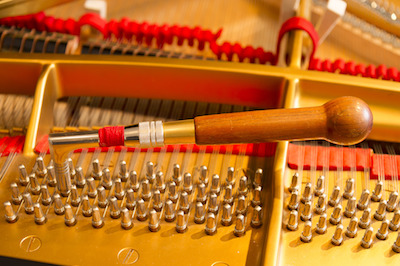f you’ve ever looked inside your acoustic piano, you’ve noticed a plethora of strings attached to tiny hammers that move every time you press down on a key.
While it might seem like a piano would have one string attached to every note, that isn’t the case. Depending on the key you strike, the note will be produced with one, two, or even three strings.
The higher notes on the piano will use three strings to produce a sound.
The lower notes will use two strings.
The lowest notes will have a single string. 
What’s more, if you use the damper pedal to create a quieter sound, the strings are impacted by the action as well. When you press the damper pedal, the action is shifted inside the piano so that the hammer strikes fewer strings – it moves down to one or two.
Head back in time; the piano was originally called piano-forte. Loosely translated, forte means strong, or loud. That’s because when striking the keys, you can produce a loud, full-bodied sound like no other instrument. The strings allow this transfer of energy to occur.
If you had just one string attached to every key, the higher notes would produce a smaller sound. Those upper notes wouldn’t have the same high-quality tone and volume that you get from the lower notes. Multiple strings provide more tension. Multiple strings give you a more robust sound.
Multiple strings also provide a tuner a greater chance of producing a quality sound. As a tuner is working to bring each note into tune, she can actually detune the string combinations to change the timbre. As she compares note to note, her goal is to produce a rich, warmer sound.
The strings on your piano are vitally important to the sound of your piano. If they are out of tune, you’ll hear it every time you press down on a key.
When was the last time you had your piano tuned?

